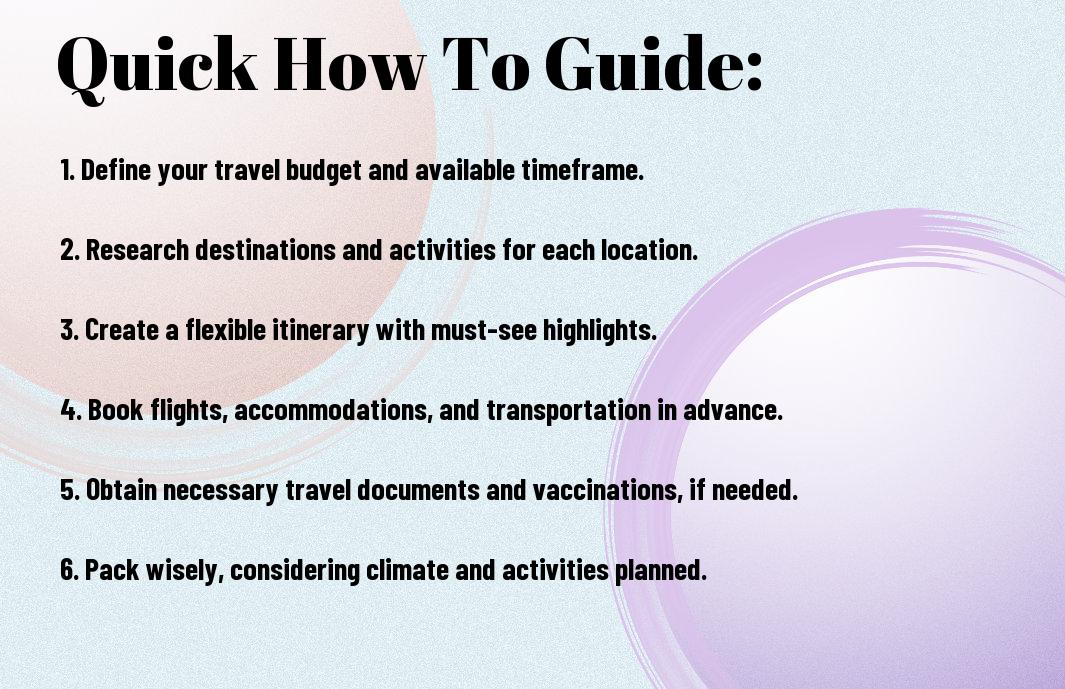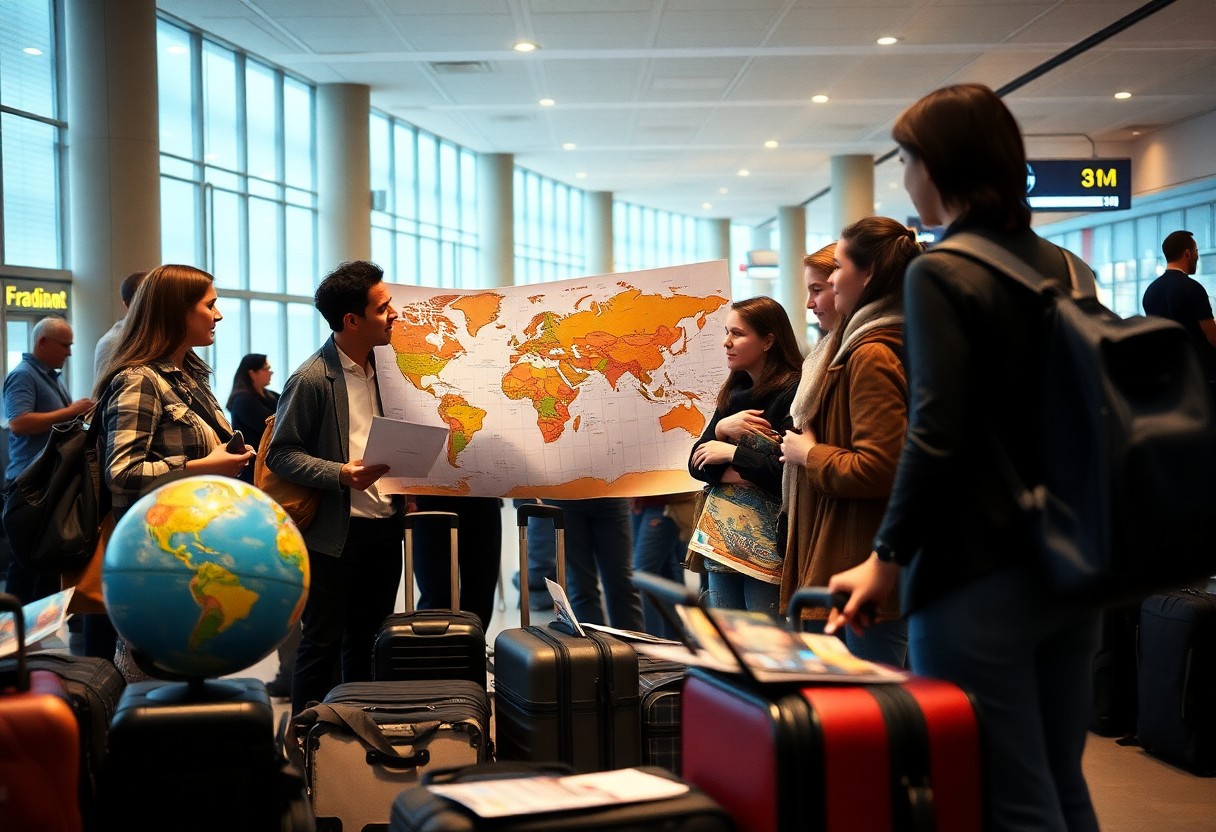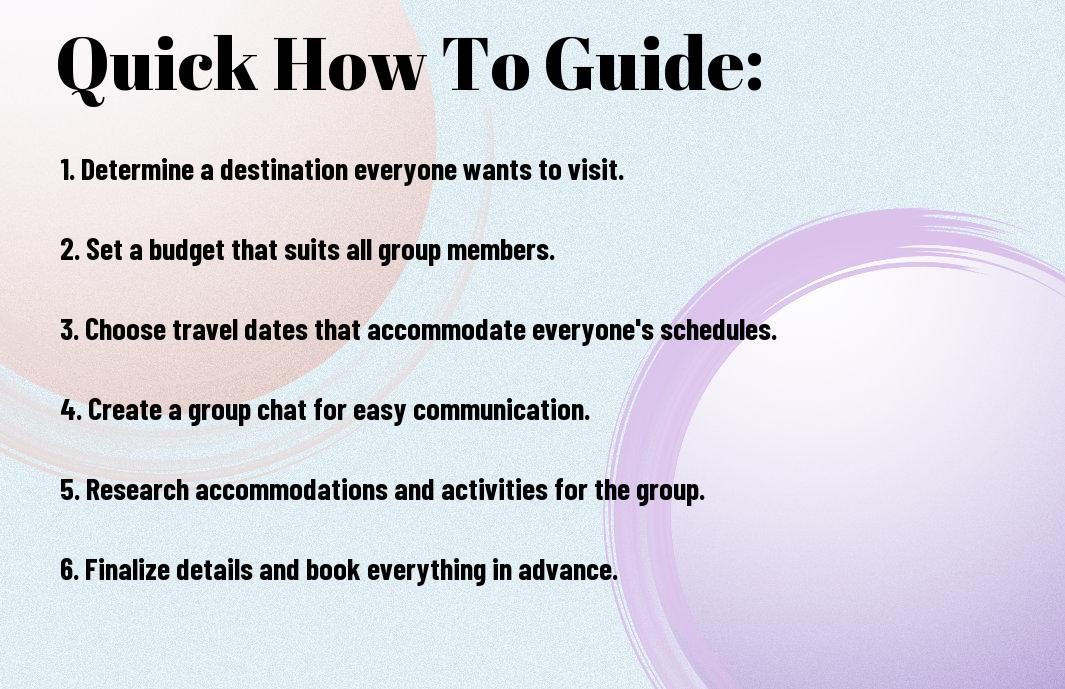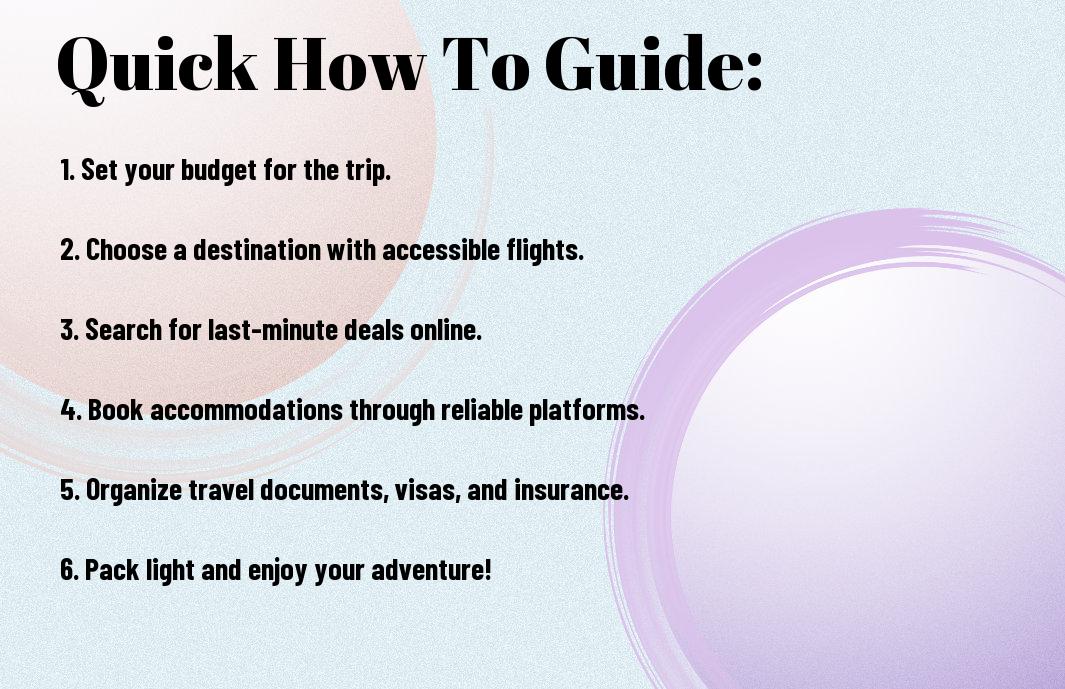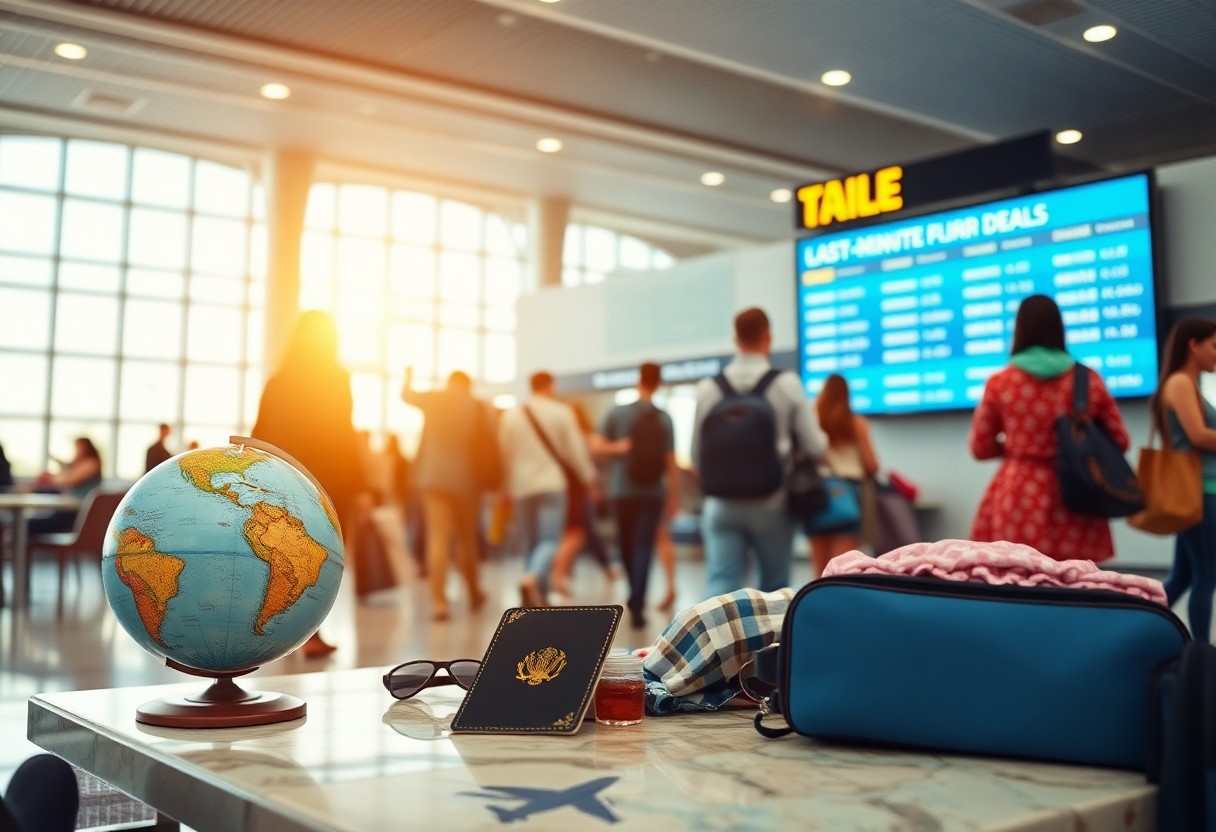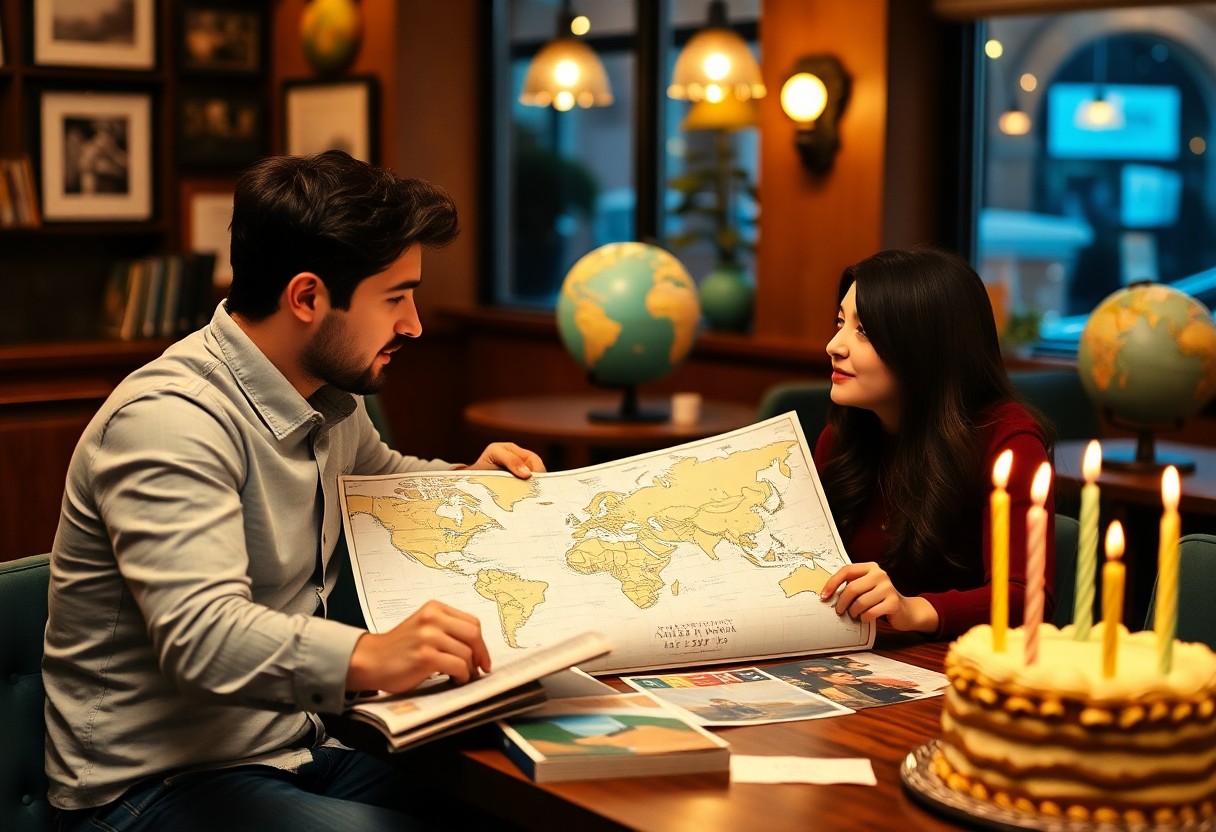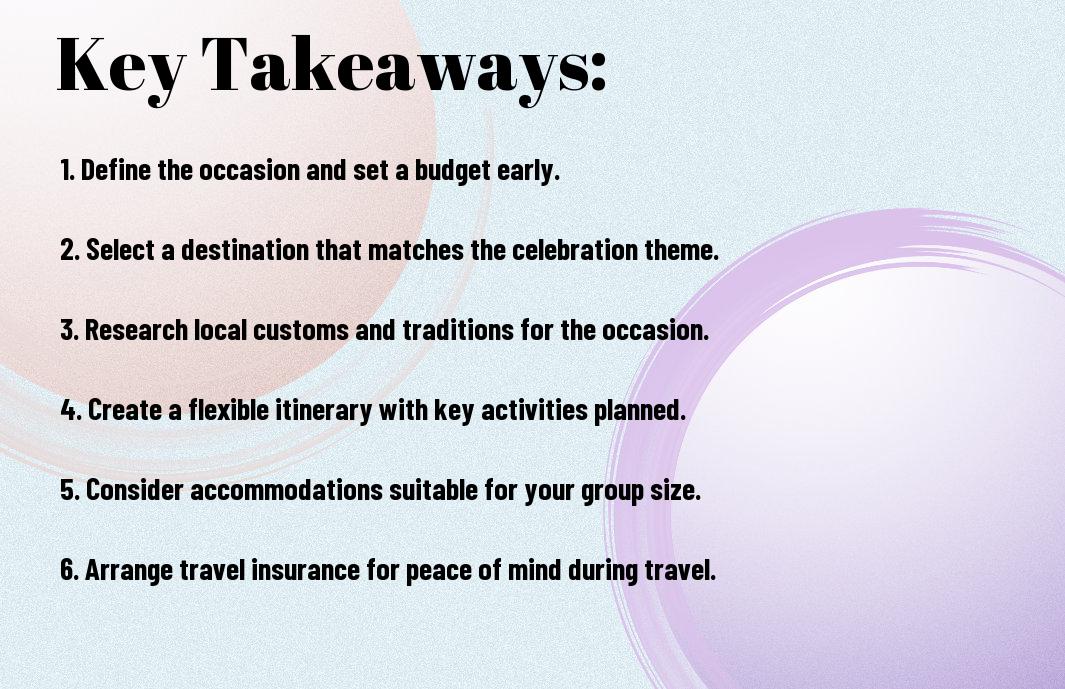Just dreaming about visiting multiple countries can be exhilarating, yet planning the perfect itinerary can seem daunting. With the right approach, you can craft a well-structured travel plan that maximizes your experiences while minimizing the hassle. From selecting your destinations to organizing your transportation and accommodations, this guide will equip you with imperative tips to streamline your planning process. For additional insights, check out this resource on How to Plan a Multi-Destination Trip: A Step-by-Step Guide!
Key Takeaways:
- Research each country’s entry requirements, including visas and vaccination statuses, to ensure a smooth travel experience.
- Budget for each destination, taking into account accommodation, transportation, food, and activities to avoid overspending.
- Transportation options should be planned between countries, whether by flight, bus, or train, to maximize time and minimize costs.
- Local culture exploration should be prioritized, allowing time for authentic experiences and understanding of each destination’s uniqueness.
- Flexibility in your itinerary enables a more enjoyable trip, allowing for spontaneous adventures and adjustments as needed.
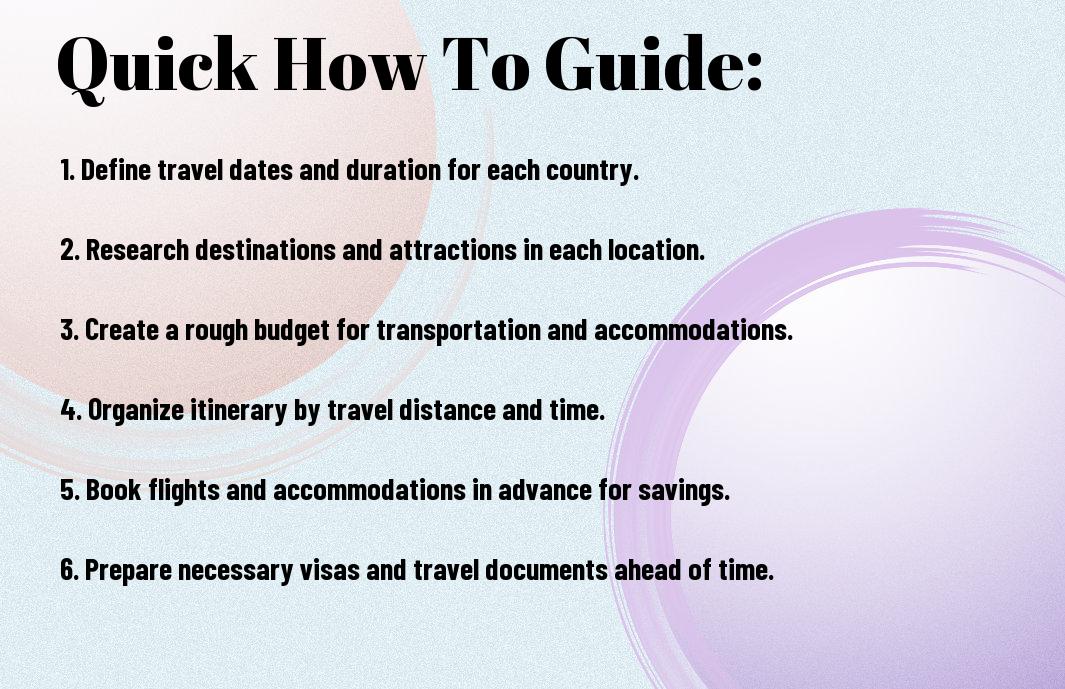
Understanding Your Travel Goals
The first step in crafting an effective multi-country travel itinerary is to clearly understand your travel goals. This involves determining what you want to achieve during your journey, whether it’s exploring diverse cultures, relaxing on beautiful beaches, or indulging in culinary experiences. By aligning your itinerary with your personal aspirations, you can create a fulfilling travel experience that resonates with you.
Define Your Purpose for Travel
On your journey, it’s important to define your purpose for travel. Are you seeking adventure, relaxation, cultural immersion, or perhaps a mix of different experiences? Clarifying your intentions will help shape your overall itinerary, ensuring that every destination aligns with your desires and expectations, ultimately leading to a more satisfying trip.
Identify Your Preferred Destinations
With a purpose in mind, you can start identifying your preferred destinations. Consider regions or countries you have always wanted to visit or places that align with your travel interests. Make a list of these destinations while keeping in mind your purpose for travel, which helps in narrowing down locations that will enhance your experience.
Destinations play a pivotal role in shaping your travel narrative. Think about the cultures, climates, and activities each place offers. Research key attractions and local customs to see which resonate with your interests. Pay attention to logistical factors like travel routes and accessibility to ensure a smooth journey. By thoroughly vetting your options, you can select destinations that promise the most rewarding experiences aligned with your travel goals.
Researching Countries and Regions
Any successful multi-country travel itinerary starts with thorough research on your selected destinations. Delve into various countries and regions, explore their geography, climate, and major attractions. Evaluate each location’s travel vibe, from bustling cities to serene countryside, and consider how these align with your interests and travel style. This foundational knowledge will empower you to create a balanced itinerary that maximizes your experiences.
Explore Travel Restrictions and Requirements
Now that you have your list of potential countries, it’s vital to explore travel restrictions and requirements for each destination. Check for visa regulations, Covid-19 guidelines, and any necessary vaccinations. Understanding these factors will help you navigate the logistics of your travels and ensure a smooth journey, avoiding any last-minute surprises.
Investigate Local Culture and Customs
You should take the time to investigate the local culture and customs of your selected countries. Familiarizing yourself with traditions, etiquette, and social norms can significantly enhance your travel experience and deepen your interactions with locals.
To truly appreciate the essence of each country, immerse yourself in its history, cuisine, and festivals. Understanding cultural nuances, whether it’s proper greetings or dining etiquette, can help you connect meaningfully with locals and enhance your overall experience. Additionally, learning a few common phrases in the local language can be a sign of respect that endears you to the people you meet, opening doors to richer experiences throughout your journey.
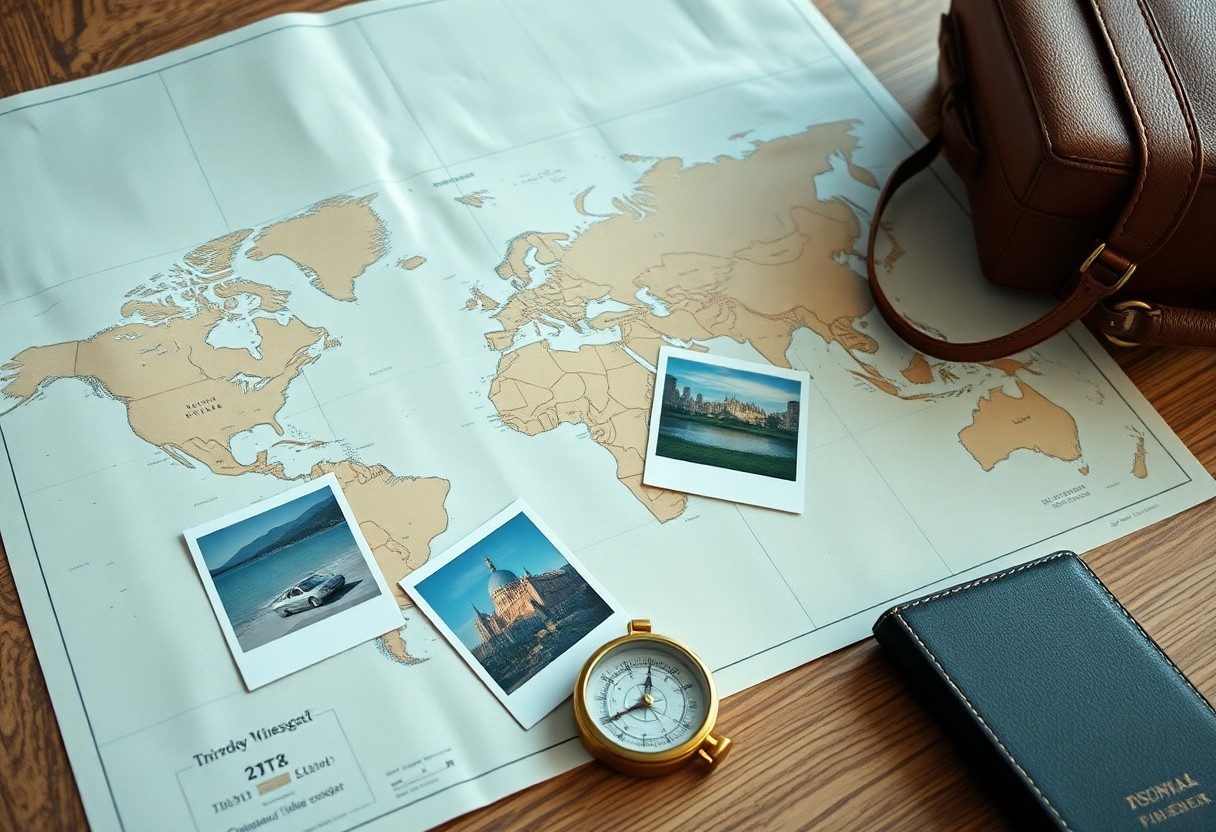
Budgeting for Your Trip
Not calculating your budget can lead to unexpected expenses and stress during your travels. To ensure a seamless adventure across multiple countries, it’s important to plan your finances ahead of time. This means considering everything from accommodation and transportation to daily spending, allowing you to focus on enjoying your journey without the worry of running out of funds.
Estimate Accommodation and Transportation Costs
One of the first steps in budgeting is to research and estimate the costs of accommodation and transportation in each country you plan to visit. Consider various options such as hotels, hostels, or vacation rentals, and contrast these prices with different modes of transport, including flights, trains, and buses. This will help you build a realistic expectation of your overall travel expenses.
Account for Daily Expenses and Activities
Assuming you have your accommodation and transportation costs figured out, the next step is to account for daily expenses and activities. These typically include meals, entertainment, local transport, and entrance fees to attractions.
A good strategy is to set a daily budget for food, activities, and incidental costs, which can vary significantly between countries. You should be mindful of the local currency and cost of living to avoid overspending. Investigate free or low-cost activities and create a spending plan that incorporates these to stretch your budget further, allowing you to fully enjoy each location without financial stress.
Creating a Manageable Itinerary
Your travel itinerary should be both exciting and realistic. To ensure you don’t overwhelm yourself, it’s imperative to balance your destinations with your available time. By doing so, you’ll give yourself ample opportunity to fully experience each location without feeling rushed. This way, you can enjoy the journey and create lasting memories.
Prioritize Must-See Attractions
Creating a list of your must-see attractions is an excellent starting point for your itinerary. Focus on places that resonate with your interests and passions, ensuring that each destination serves a purpose in your travel experience. This prioritization will help you eliminate unnecessary stops and enhance the quality of your trip.
Allocate Time Wisely
Allocate time wisely to avoid burnout and maximize your travel experience. Consider factors like travel distances, local culture, and activities available in each destination when determining how long to spend in each location. This thoughtful planning will help you appreciate the unique offerings of every place you visit.
A well-planned itinerary takes into account not just the duration but also the pace of your travels. Aim for a balance that allows for spontaneous exploration as well as scheduled activities. Factor in travel times between locations, and allow for downtime to relax and absorb your surroundings. By doing this, you ensure each experience is enjoyable rather than a rushed checklist.
Transportation Considerations
For a seamless multi-country travel experience, you need to prioritize your transportation options early in the planning process. Consider distances, travel times, and the availability of various modes of transport such as flights, trains, buses, and car rentals. Research routes and schedules to ensure that your itinerary flows smoothly, enabling you to maximize your time exploring each destination without unnecessary delays.
Choosing the Right Modes of Transport
Some destinations are best explored by train, while others may require a quick flight or a scenic bus ride. Evaluate the pros and cons of each transport mode based on your budget, travel time, and comfort preferences. Local transportation options such as subways or rideshare services can also enhance your experience and provide flexibility during your travels.
Planning for Inter-Country Transfers
For an efficient transition between countries, it’s important to schedule your inter-country transfers thoughtfully. Keep in mind visa requirements, border crossing procedures, and any necessary documentation that may affect your travel timeline. Planning these transfers in advance will help you avoid last-minute surprises that could derail your itinerary.
It is wise to leave buffer time between transfers to accommodate any potential delays, such as customs or transportation issues. Check for direct connections to save time, or look into overnight options for longer distances. Being aware of the best times to travel can also lead to significant savings, especially if you’re flexible with your travel dates. Always consult local transportation websites for up-to-date information and options available to ensure a stress-free journey.
Packing Essentials for Multi-Country Travel
After finalizing your multi-country travel itinerary, it’s time to pack smartly. You’ll want to consider the different cultures, climates, and activities you will experience in each destination. Prioritize versatile clothing, travel-sized toiletries, and necessary gadgets to ensure you’re prepared for any situation without overloading your luggage. With careful planning, you can enhance your travel experience while keeping your bags manageable.
Packing Light vs. Packing Well
Light packing focuses on minimizing the weight of your luggage, while packing well emphasizes having all necessary items without excess. By choosing a few versatile clothing pieces and necessary accessories, you can enjoy a more convenient travel experience. Aim for quality over quantity, ensuring every item serves multiple purposes to keep your baggage light yet functional.
Adapting to Varying Climates
If you are traveling across multiple countries, varying climates are a significant consideration. You’ll face different temperatures, humidity levels, and weather conditions that require a tailored packing approach. Having adaptable layers will ensure your comfort no matter where your travels take you.
Essentials like a lightweight rain jacket, breathable clothing, and a compact umbrella can be lifesavers during unexpected weather changes. Packing a versatile scarf can also provide warmth in colder destinations or serve as a lightweight accessory. By selecting adaptable pieces and checking weather forecasts for each location, you’ll be prepared to enjoy your trip regardless of the climate challenges you may face.
Summing up
So, as you plan your multi-country travel itinerary, start by setting clear priorities for your destinations and experiences. Organize your travel dates, book your accommodations in advance, and consider travel logistics between countries to save time and effort. Keep flexibility in mind to adapt to unforeseen changes, and don’t hesitate to research local cultures and experiences to enrich your journey. With careful planning and organization, you can create a seamless and enjoyable travel adventure across multiple countries.
Q: What are the first steps to take when planning a multi-country travel itinerary?
A: The initial steps involve defining your travel goals and preferences. Consider what countries or cities you want to visit and the duration of your trip. It’s helpful to create a list of must-see attractions, experiences, or activities in each location. Next, research visa requirements and any travel restrictions for each country, as they can dictate the order and feasibility of your travels. After determining the countries, outline a rough itinerary considering your travel style—whether you prefer a slow-paced journey or a more packed schedule. It’s best to plot out a route that makes sense geographically to minimize travel time between destinations.
Q: How can I make travel between multiple countries more efficient?
A: To enhance the efficiency of travel between countries, consider the following strategies: first, utilize budget airlines for inter-country flights, as they often offer competitive rates and extensive networks. Additionally, research train and bus options, as many regions have an efficient public transport system that can be cost-effective. Choose destinations that are geographically close to each other to reduce travel times, and try to group neighboring countries together in one leg of the trip. It’s also advisable to check travel schedules ahead of time and book tickets in advance when possible to ensure you have a clear plan in place.
Q: What should I consider regarding accommodations while planning a multi-country itinerary?
A: When planning accommodations for a multi-country itinerary, consider factors like location, budget, and amenities. Prioritize staying in central areas to reduce transportation time and costs, allowing you to easily access attractions and local culture. Research different types of accommodations, such as hotels, hostels, or vacation rentals, to align with your travel style and budget. Additionally, it’s wise to read reviews and look into cancellation policies, especially when your itinerary may shift. Booking accommodations in advance can often yield better rates, but maintaining flexibility allows for spontaneous discoveries along the way.
